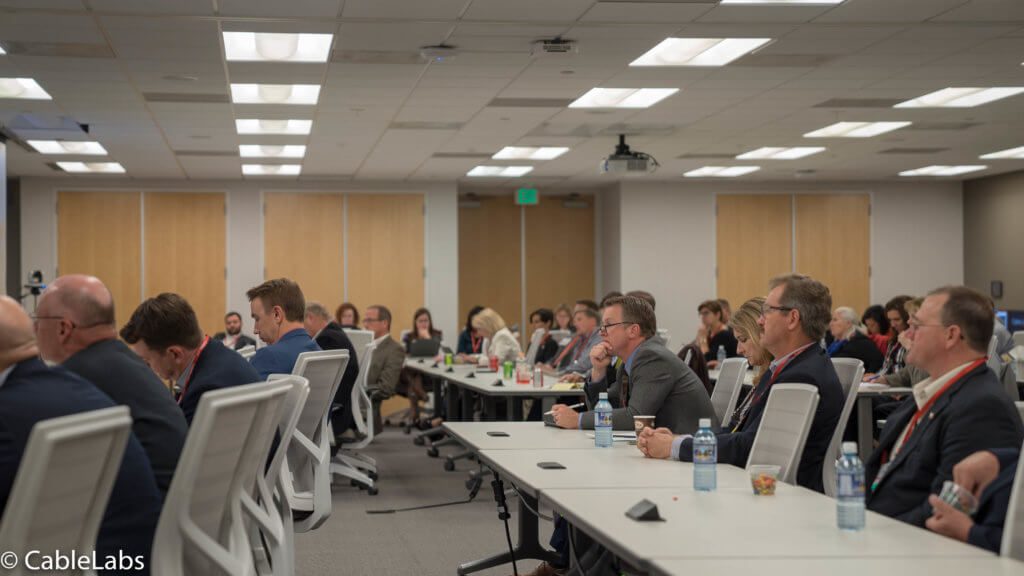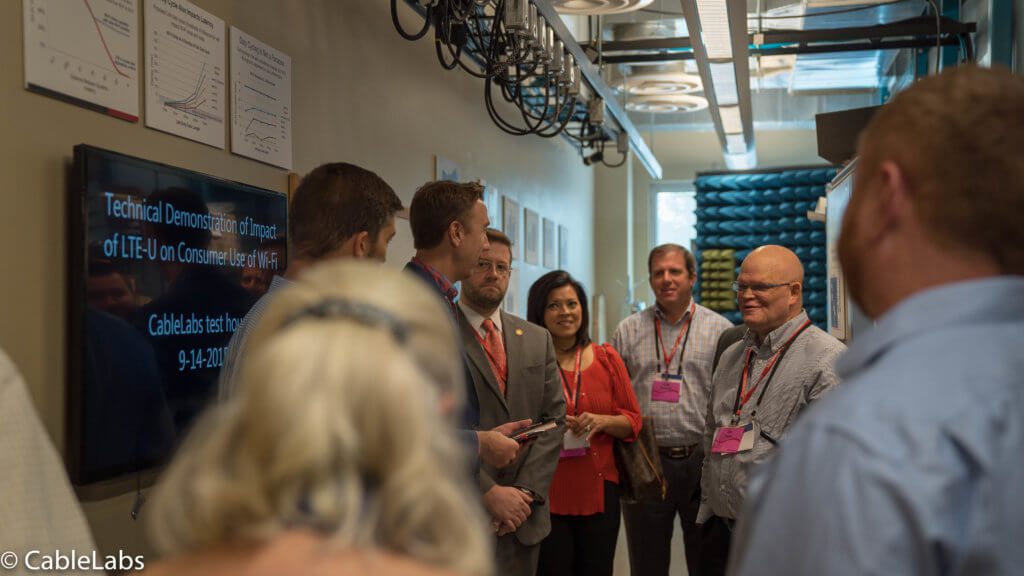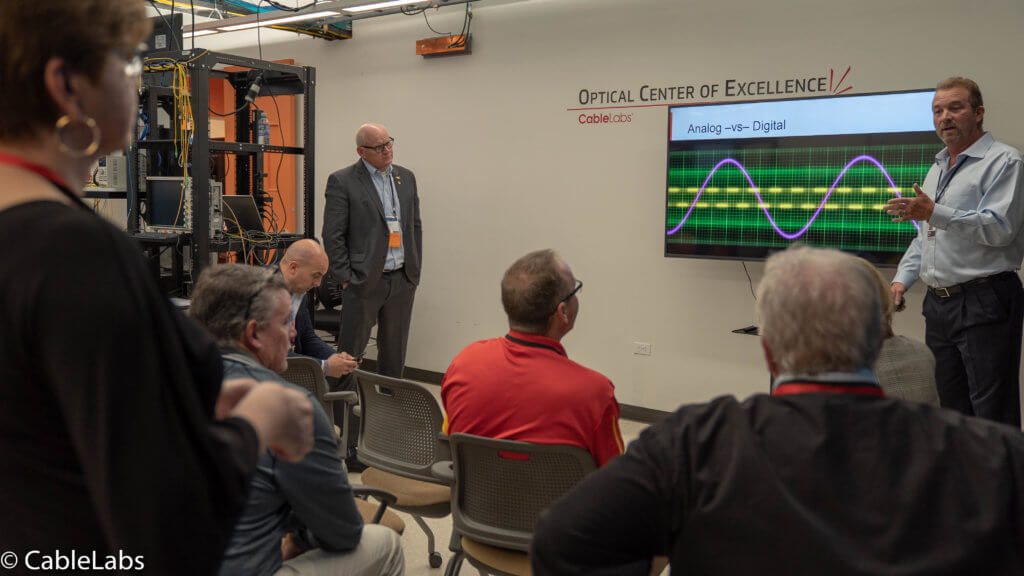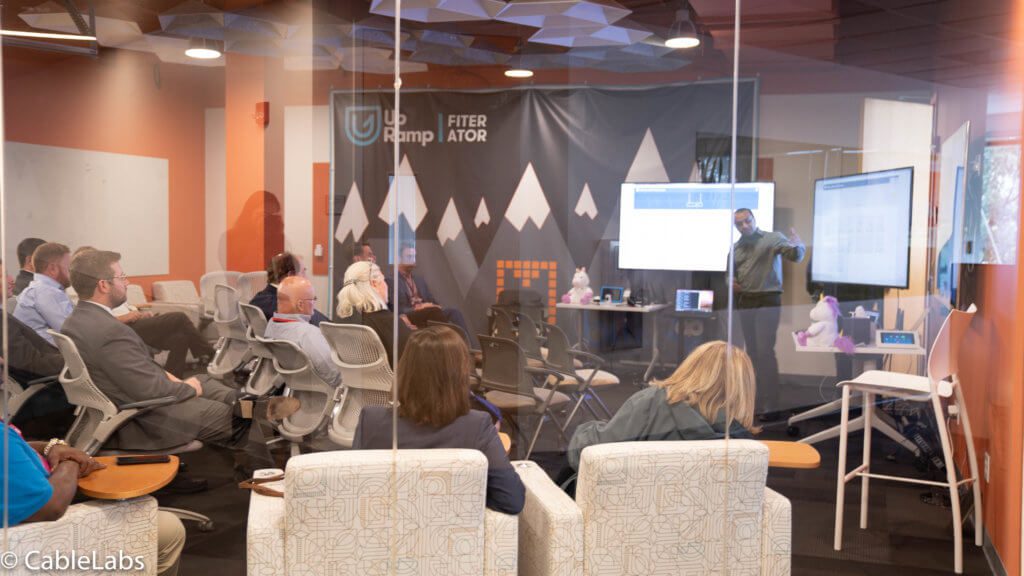News
6 GHz Spectrum: Leading the Way in a Win for Wi-Fi

It is a historic day. At a time when we are all relying on broadband and Wi-Fi more than ever to maintain relationships and be productive, the Federal Communications Commission (FCC) has decided to release a new swath of wireless airwaves – known as the 6 GHz frequency band – to ensure these connections are resilient into the future. The last time the FCC opened a major chunk of bandwidth for Wi-Fi was more than 15 years ago. And with today’s action, we are tripling the amount of spectrum available for Wi-Fi and other innovations that ride on unlicensed frequencies, this is a big deal.
CableLabs applauds the FCC’s leadership in taking this step. Opening the 6 GHz band will unleash unparalleled innovation with the deployment of Wi-Fi 6E and future generations such as Wi-Fi 7, and will also help to bring multi-gigabit connectivity and continued expansion of broadband performance for Americans in communities of all sizes.
A diverse set of innovative companies support this action and are developing new technologies to put the new frequencies to good use. And for the cable industry, this is a perfect complement to our 10G broadband roadmap. Opening 1.2 gigahertz of bandwidth in the 6 GHz spectrum band will ensure that abundant wireless bandwidth is available for consumers’ experience of multi-gigabit broadband.
A Big Improvement for Wi-Fi Users
Since the last time a major swath of spectrum was allocated for Wi-Fi, more than a few things have changed in the way we connect, work, learn and entertain. Landlines have been replaced by smartphones, conference calls have become virtual meetings, online courses have opened up a new world of learning and Netflix now streams online instead of mailing DVDs – just to name a few things that have changed in the last 15 years. Wi-Fi has handled a major share of this digital migration and has improved technologically over many 802.11 generations to enable these user experiences, so it is past due for a spectrum update.
And now, with people working, learning and connecting from home more than ever, we are seeing just how important Wi-Fi is as the gateway to broadband connectivity. Data traffic is up, the number of devices connected is up and even subscribership is up. Broadband and Wi-Fi are enabling our economy and society to continue functioning during our current public health crisis, and cable networks are holding up very well to these demands. This is an important time for the Commission to enable continued Wi-Fi progress.
What Comes Next for Wi-Fi
For Americans, 6 GHz spectrum will mean improved connectivity as new wireless innovations are brought to market. Cable will deploy these new wireless technologies in coordination with ongoing network investment to ensure robust connectivity in the future.
Elsewhere, outside of the United States regulators should take a close look at this FCC action and follow suit to advance 6 GHz spectrum access in their own jurisdictions. The future of Wi-Fi depends on it.
CableLabs’ Role in This Important Milestone
Nearly every spectrum policy decision rests on a judgement of its potential wireless interference impact; without the proper technical rules of the road, incompatible wireless systems can impede each other’s operations. CableLabs therefore focused its efforts on an intensive technical study of the potential impact of Wi-Fi operations in 6 GHz to the other wireless systems that operate in the band.
Working with the FCC, we assessed the appropriate technical parameters of 6 GHz Wi-Fi to ensure that there will be no harmful interference to point-to-point microwave links, electronic news gathering operations and other incumbent systems that also use these frequencies. CableLabs ultimately determined that low-power, indoor Wi-Fi has a very low risk of impeding these other systems. We are extremely pleased that the FCC agreed with our conclusions and noted how crucial our work was to their decision. I am incredibly proud of the CableLabs team and grateful to the Commission staff for our collaboration.

Policy
Legislators at the Labs

Eighty politicians walked into a lab... That's not the start of a joke, it was actually the start of our week here at CableLabs! We were excited and honored to host state representatives and senators from across the U.S. on Monday, and to show them the exciting innovation happening in the cable industry.
Our day was all about innovating the future of connectivity. We started by talking about the deployment of gigabit networks, which now reach the majority of Americans, and we showed them the research that makes these services a reality over the existing hybrid fiber coaxial networks of the cable industry. We talked about the importance of wireless connectivity and spectrum research, since everyone connects to broadband via Wi-Fi, and a majority of CableLabs' members are also mobile operators. We focused on cybersecurity – an increasingly important area, given the growth of connected (‘IoT’) devices – and what we are doing to help as part of the broader Internet ecosystem. And finally, no visit to CableLabs would be complete without experiencing the applications that ride over gigabit networks – immersive media, virtual reality, and the holographic effects of light fields were a highlight, and are featured in our latest Near Future film.
So, what do you get when you have eighty politicians in the Labs? Lots of questions! How should we think about 5G? What can we do to extend broadband service to areas that don’t have access? How can we realize the educational possibilities that come with broadband?
All great questions, and at a high level, the answer is that there is no one single technology solution. That is why CableLabs is pushing the envelope of performance on cable, fiber, and wireless, and other technologies, bringing next-generation connectivity to consumers.
But, there is a common thread for policymakers: The innovations we develop at CableLabs are all at least three years away from being realized in the market. The policy environment can help to put new technologies into the hands of consumers through stable, predictable, and consistent policy that is conducive to investment and risk-taking. Since there is that interaction between technology policy and innovation, we appreciated the opportunity to host a great group of elected representatives this week.
CableLabs is the global innovation hub for the cable industry and provides leaders across the globe with technology insights on which to base decisions of significance.
To learn more about Rob and CableLabs tech policy work, please click here.
Policy
A Super-Fast, Super-Connected Wireless Future Requires a Balanced Spectrum Policy

This article was originally published by Morning Consult on Aug. 9, 2018. You can find the post here.
Recently, the Senate Commerce Committee held a hearing on the race to 5G, exploring how we can harness the power of wired and wireless broadband to drive transformative communications innovation, and what the government can do to support and accelerate industry efforts. Testimony from a range of ecosystem players – mobile, cable, satellite, and equipment suppliers – made clear that the 5G vision of ultrafast speeds, minimal latency, and expanded coverage across the country will be delivered by a variety of new technologies that will transform our connected lives.
Getting there will require policymakers to unleash wireless bandwidth – the spectrum – that will enable this new world.
At the hearing, industry representatives agreed that the future of connectivity will require access to robust licensed, unlicensed and shared spectrum. Unlicensed spectrum in particular, as Charter Communications Inc.’ Craig Cowden pointed out, will play a key role in the delivery of 5G.
Unlicensed spectrum is open to all and is already intensively used for Wi-Fi, which Americans rely on for broadband access. The central role of unlicensed spectrum will continue in our 5G future, as the growth of Wi-Fi continues and new technologies are developed. It is therefore essential that policymakers include unlicensed spectrum in any 5G discussion, and that Congress and the FCC work to expand this wireless bandwidth.
Wi-Fi and unlicensed spectrum already are central to Americans’ everyday lives. Wi-Fi carries the majority of all internet traffic now, with 3 billion Wi-Fi devices being deployed this year alone. Last year, over 60 percent of all mobile data traffic was offloaded from cellular networks onto Wi-Fi. Internet of Things devices, which will reach over 11 billion this year, rely on Wi-Fi more than any other connectivity technology. It is a ubiquitous element of our modern economy – e-commerce, medical services, transportation and finance, among other sectors, are all dependent on Wi-Fi connectivity.
Wi-Fi added more than $525 billion in economic value to the U.S. economy just in 2017, according to one estimate. In the coming years, Wi-Fi is expected to grow further, offering increased reliability, lightning-fast gigabit speeds, and seamless secure connectivity. The cable industry – including my organization, CableLabs – is working hard to improve Wi-Fi and other unlicensed technologies for consumers in support of the 5G vision.
There is now a specific opportunity to give this innovation a boost through spectrum, in particular, the 5 gigahertz frequency band. Parts of the 5 gigahertz band are already used by Wi-Fi, and it is home to many new wireless innovations. But to fully enable these latest technologies, the spectrum available for unlicensed services in this frequency range must be expanded upward, into the 5.9 gigahertz range. When this happens, industry can and will rapidly put this spectrum in the hands of consumers.
The 5.9 gigahertz band is our country’s best near-term unlicensed spectrum opportunity for several reasons. First, it offers sufficient bandwidth to support wireless innovation through a wide range of technologies and services. Second, since it is an outgrowth of already heavily-used frequencies, it is easily adopted by wireless equipment – a rare opportunity in spectrum allocation, where it usually takes years to get new bandwidth into the hands of consumers. Third, the band is largely unused and has been for the past 20 years. No other spectrum opportunity has fewer existing services to consider.
Having spectrum available that promotes innovation and connectivity is critical to our connected future. Making the unlicensed 5.9 gigahertz frequency band available for new wireless services now would represent one significant step forward in the global race to 5G.
Interested in learning more? Take a look at our Inform[ED] Insights by clicking below.
![Read our Inform[ED] Insights](https://no-cache.hubspot.com/cta/default/1697621/359c20b6-c91f-4f06-865d-68cb97b38db7.png)
Wireless
We Need a Spectrum Festivus for the Rest of Us

Season’s greetings! As we get our annual lists together, here’s one I bet you forgot: Spectrum. But, I’m sorry to tell you, without spectrum that shiny new iPhone X won’t live up to its potential.
Spectrum is the fuel for our wireless communications revolution. It is the bandwidth in the sky – literally, we’re talking about airwaves - and without it, our devices suffocate. We now have more mobile phones than people, and the "things" in the Internet of Things number in the billions, with more to come. With all of that growth, we are running out of spectrum space!
How to get more?
Well, it’s complicated. Spectrum is apportioned by the government, so ultimately we need regulators to make more space for us. It’s a pretty technical job, and CableLabs has been involved in pushing that forward for years, particularly for Wi-Fi and other innovative technologies. But, it is a job that’s never done, because we keep seeing more wireless growth. So there’s much more for the government to do here. And we have ideas… are you listening, Washington, Ottawa, Beijing, and Brussels?
But, there’s an industry role here too.
With the spectrum we have, we need to make the best use of it – and that will be true regardless of how much more spectrum governments make available. That’s up to us to figure out, especially in Wi-Fi spectrum, which is also home to many other technologies. That’s right, we have to learn to share. This is done through technical standards, which set the rules of the road so that we all play nicely with each other. As more technologies are developed – LTE-U was just the beginning - and with more and more devices sharing the spectrum, playing nicely is going to become ever more important.
So, this holiday season, spectrum sharing is caring. Happy holidays!
You can learn more about spectrum by watching our video below:

Wireless
2 Resolutions for World Wi-Fi Day 2017
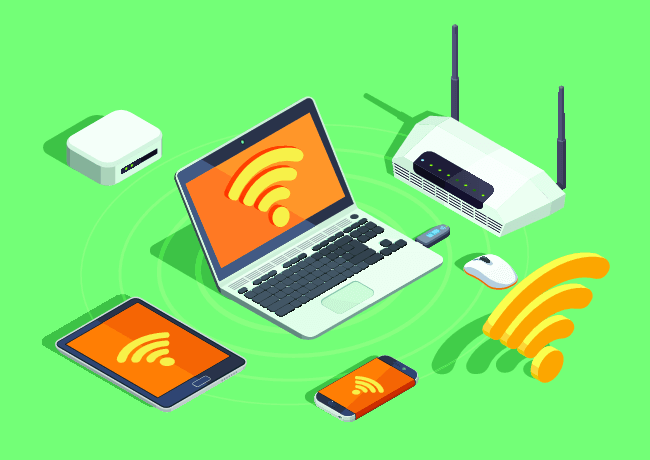
It’s World Wi-Fi Day! Really, given how much we work on Wi-Fi technology, every day is Wi-Fi Day at CableLabs. Since the rest of the world has decided to take note, it feels a bit like New Year’s. So, how about a couple of resolutions?
In the coming year, we in the Wi-Fi industry should resolve to support the continued growth of Wi-Fi with two major initiatives:
1) Enhanced Wireless Spectrum Access
Spectrum, or the airwaves that wireless communication travels over, is the key ingredient for Wi-Fi. While CableLabs and others in the industry work hard to improve Wi-Fi technologies, it is all for naught if we don’t have the wireless bandwidth to make it work. This is becoming more important as wireless use grows, putting pressure on the capacity we have today.
To stick with this resolution, we’ll need the help of regulators around the world that control access to spectrum. For example, the latest Wi-Fi technology 802.11ac is known as “gigabit Wi-Fi” for the high performance it offers. Unfortunately, due to lack of spectrum, the full potential of this technology can’t be realized.
To fix this, we must look at the 5 GHz frequency band. You probably have a router at home that is “dual band”, meaning it uses 5 GHz. If you acquired it in the last year or two, it is likely 802.11ac (“gigabit Wi-Fi”) capable. We need to open up more spectrum for Wi-Fi in the 5 GHz range to fully enable this technology. Particularly as wired broadband speeds continue to increase, we need to be sure that the final step to your wireless device isn’t a bottleneck.
Progress on enabling Wi-Fi access to additional spectrum requires technical acumen, to ensure that Wi-Fi can share the airwaves without causing harmful interference to other services. That’s where our team at CableLabs comes in.
In the US, the FCC is examining how Wi-Fi can share with transportation communications technology in the upper part of the 5 GHz band, an issue they have been looking at for over four years. We’ve studied this, and we believe spectrum sharing technology supports this proposal. It’s time to move forward so that consumers can realize the full benefits of gigabit Wi-Fi.
CableLabs has applied our expertise to questions of spectrum sharing before, with a lot of success. In 2014, we did the behind-the-scenes work to open up the lower part of the 5 GHz band for Wi-Fi in the US. And just last month, the Canadian government followed this precedent.
2) Enable Reliable Coexistence Between Wi-Fi and Other Technologies
Though most people may not think too much about 5 GHz spectrum, those who do, probably think of it as Wi-Fi spectrum. That’s understandable since there are literally billions of Wi-Fi devices out there. However, more accurately, it is unlicensed spectrum (or license-exempt, in Europe). Meaning, other technologies also use the same frequencies.
Unlicensed spectrum is becoming more popular, and new technologies are moving in. Those that have a similar usage pattern are likely to run into Wi-Fi. Therefore, these new technologies need to be designed to play nicely, just as Wi-Fi is designed to do with its listen-before-talk protocols. Coexistence between technologies in unlicensed spectrum is of paramount importance to ensure that consumers win from new wireless innovation.
The leading case in this area is, of course, LTE-U, which we’ve written about extensively. CableLabs worked diligently to surface problems with LTE-U coexistence technology and led industry-wide efforts in the Wi-Fi Alliance to develop tests that can verify how well LTE-U equipment shares spectrum with Wi-Fi before it hits the street. Industry collaboration is an effective means of addressing coexistence issues and mobile carriers have stated that they will stick with the results of that process. We have since seen LTE-U devices approved after going through the tests.
The LTE-U story is, for the most part, a good example of how industries can come together to protect consumers that rely on unlicensed spectrum. However, the level of collaboration seen since then has, unfortunately, diminished significantly. Specifically, there isn't visibility into how the industry-agreed coexistence tests are implemented and used. No LTE-U vendor has released the results of its coexistence tests, even though they are happy to tout that they have passed with flying colors. Transparency is important to validate coexistence performance and mobile carriers and vendors should be more forthcoming.
Beyond LTE-U, which is a proprietary and non-standard technology aimed at unlicensed spectrum, we have LAA-LTE, which is the global standard version developed at 3GPP. There’s more reason for optimism around LAA coexistence since it uses listen-before-talk etiquette similar to Wi-Fi. But, when it comes to validating that optimism through coexistence tests, the work at 3GPP has been sorely lacking.
Just a couple of weeks ago, a key 3GPP working group produced what it deems to be final coexistence testing guidance associated with LAA (To read more download here). This work product does little to reassure consumers that rely on unlicensed spectrum. The guidance recommends only limited testing, which will not come close to approximating real-world technology interactions. Additionally, mobile carriers and vendors may not follow even this limited guidance since it is completely optional under the 3GPP specification. It is important that we get coexistence right since new technologies are coming, MulteFire, eLAA, and 5G, that will also use unlicensed spectrum alongside Wi-Fi.
These are our two big World Wi-Fi Day resolutions. Help us celebrate World Wi-Fi Day by commenting yours below. Be sure to check out our blog posts "Solutions for Whole Home Wi-FI Coverage," Carrier Wi-FI is Now Certified Vantage" and "Multiple Access Point Architectures and Whole WI-Fi Home Coverage" to read more about how CableLabs is engaged in Wi-FI efforts and do our best to protect consumers, making new wireless innovations a win for everyone!
Policy
A Milestone in Wi-Fi / LTE-U Coexistence

Today is an important milestone for unlicensed spectrum coexistence - the Wi-Fi Alliance (WFA) has released its plan for testing how well LTE-Unlicensed coexists with Wi-Fi.
This culminates many months of work by many expert engineers within the WFA and its membership, including CableLabs staff. The outcome is that we now have a definitive set of tests, based on real-world consumer data, against which to judge LTE-U – and we can move past the competing technical studies that were the hallmark of 2015.
The WFA and its staff are to be commended for bringing all sides to the table on this issue of such importance for broadband consumers everywhere. The test plan, developed in record-time, is a product of compromise by all sides, and LTE-U proponents participated robustly in the process. There are a number of tests that CableLabs supported as important that ultimately were not adopted. But the final product is nevertheless essential – both in validating coexistence performance of any LTE-U device proposed for deployment, and as a sign that diverse industry interests can work toward solutions as wireless access becomes ever more important for consumers.
CableLabs will continue to be engaged as the WFA moves to implement this plan with authorized test labs. We look forward to a transparent process with results reported publicly by the WFA. As we move to this implementation phase, it is worth describing what the test plan does, in order to understand why it is so important.
At a high level, the test plan does the following:
- Checks that LTE-U devices select the most lightly used channel, as LTE-U proponents say they will do;
- Ensures that new Wi-Fi networks can access the channel when LTE-U is active;
- Measures the impact to Wi-Fi throughput and latency from LTE-U; and,
- Ensures that LTE-U adapts its use of the spectrum in response to variation in consumer use of Wi-Fi, as occurs in the real world, in real time.
And it does all of this at signal levels that have been shown with real-world data to be reflective of consumer use of Wi-Fi hotspots. These tests are necessary due to the well-documented shortcomings in the LTE-U Forum coexistence specification, and the lack of standardized test procedures to date, which has yielded vastly different coexistence conclusions. For more information on our views of the test procedures, see Jennifer Andreoli-Fang’s contribution to the August workshop of the WFA, which is available here.
Reasonable compromises have been made by all sides in developing this test plan. It is time to move forward using the outcome of this process, in full, as the sole source of reliable determinations of LTE-U coexistence.
News
Liberty Global and CableLabs Join MulteFire Alliance
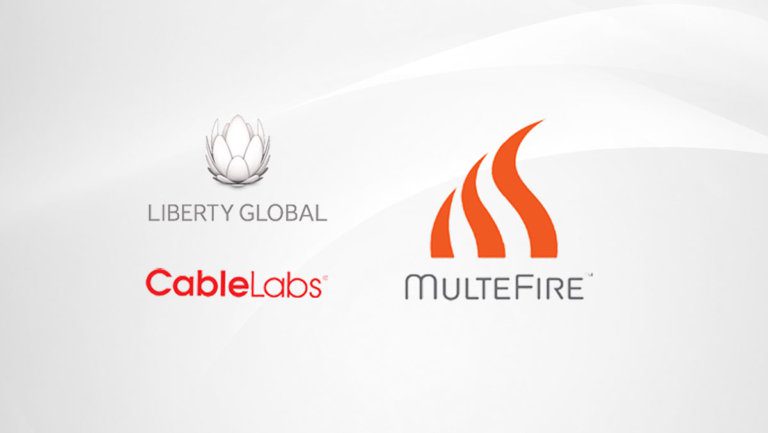
Today, CableLabs is taking a significant step to drive the development of next-generation wireless technology. We are excited to announce that, along with our member Liberty Global, we are joining the MulteFire Alliance, an open consortium dedicated to making mobile technologies more widely available for use in shared, unlicensed spectrum.
MulteFire is based on 3GPP License Assisted Access LTE (LAA-LTE), which uses listen-before-talk etiquette to share spectrum in a manner similar to Wi-Fi. But unlike LAA, MulteFire will place control signaling entirely in the unlicensed band, breaking the reliance on licensed spectrum and mobile networks. This is a capability that we and others have proposed several times in 3GPP, as yet without successful adoption in that body. Our hope is that pursuing this technology in the Alliance will enable its rapid integration to global standards.
We see this step as the basis for renewed collaboration on next-generation wireless technology, which will become ever more important as we move toward 5G. Reliable coexistence, full transparency, and deep engagement with partners have long been central to our work on technologies that use unlicensed, shared spectrum. These same principles will continue to apply as we work with the MulteFire Alliance, 3GPP, the Wi-Fi Alliance, IEEE, and other groups going forward.
Below is the full copy of the joint press release that was issued today:
Liberty Global and CableLabs Join MulteFire Alliance
Next-generation wireless technology gets major boost as two leading players in cable join forces with Wireless Consortium
London, United Kingdom and Louisville, Colo. – Sept. 21, 2016 – Today, Liberty Global, the world’s largest international TV and broadband company, and CableLabs, the innovation-focused R&D lab for the global cable industry, announced that they have joined the MulteFire Alliance, an independent, diverse and international member-driven consortium dedicated to developing next-generation wireless technology. Through collaboration with the Alliance, Liberty Global and CableLabs can improve the wireless experience and make the technology more widely available to consumers.
“Wireless connectivity has become critically important for consumers,” said Balan Nair, CTO of Liberty Global. “By joining the MulteFire Alliance, we are driving the future of wireless for our customers.”
The main focus of the MulteFire Alliance is to ensure that next-generation LTE mobile standards are compatible with shared and unlicensed spectrum. This compatibility ensures that the next generation technology is more widely available and that it can coexist alongside Wi-Fi and other technologies. What also makes this technology unique is that operators without access to the licensed spectrum still will be able to use it, breaking down barriers to entry and opening the door to greater innovation.
“This step will arm the cable industry with a new wireless technology that builds on our success in providing Wi-Fi and mobile services and complements the industry’s fixed broadband technology leadership,” said Ralph Brown, CTO of CableLabs.
Currently, the MulteFire Alliance is working to adapt 3GPP-based mobile wireless standards for shared and unlicensed spectrum so that the technology is broadly available and fairly coexists with Wi-Fi and other technologies. MulteFire is based on 3GPP Release 13 License Assisted Access LTE (LAA) and Release 14 enhanced LAA (eLAA), which uses Listen-Before-Talk (LBT) etiquette to share spectrum in a manner similar to Wi-Fi.
Unlike LAA, however, which is anchored to licensed spectrum and must be used in conjunction with a mobile network, MulteFire will operate entirely in unlicensed or shared spectrum, so that operators without licensed mobile spectrum can utilize it. This “standalone” functionality has been proposed in the 3GPP standards body for both LTE and 5G. By building this capability in the Alliance, its member companies will enable its adoption in global standards and the corresponding broad benefit of wireless innovation.
“We appreciate that the Alliance is committed to transparency and collaboration, given the importance of unlicensed spectrum to broadband access,” said Rob Alderfer, Vice President of Technology Policy at CableLabs. “As we move toward ever greater sharing of scarce spectrum resources, reliable coexistence across technologies is essential as we continue to innovate. It’s what we believe is the most critical aspect of the Alliance, and one that will be important as the industry moves toward 5G standards.”
“Operators in the cable industry are ideal partners in our effort to develop new wireless technology and we are pleased to have CableLabs and Liberty Global join us,” said Mazen Chmaytelli, MulteFire Alliance president. “The Alliance is open for broad, global participation, and since one of our goals is to drive our work into global standards, we are establishing liaisons with 3GPP, CBRS Alliance and IEEE to keep them apprised of our progress.”
Other members of the Alliance include leading technology suppliers such as Qualcomm, Intel, Nokia and Ericsson. A full list of members can be found here.
About Liberty Global
Liberty Global is the world’s largest international TV and broadband company, with operations in more than 30 countries across Europe, Latin America and the Caribbean.
We invest in the infrastructure that empowers our customers to make the most of the digital revolution. Our scale and commitment to innovation enables us to develop market-leading products delivered through next-generation networks that connect our 29 million customers who subscribe to over 59 million television, broadband internet and telephony services. We also serve 11 million mobile subscribers and offer WiFi service across seven million access points.
Liberty Global’s businesses are comprised of two stocks: the Liberty Global Group (NASDAQ: LBTYA, LBTYB and LBTYK) for our European operations, and the LiLAC Group (NASDAQ: LILA and LILAK, OTC Link: LILAB), which consists of our operations in Latin America and the Caribbean. The Liberty Global Group operates in 12 European countries under the consumer brands Virgin Media, Ziggo, Unitymedia, Telenet and UPC. The LiLAC Group operates in over 20 countries in Latin America and the Caribbean under the consumer brands VTR, Flow, Liberty, Mas Movil and BTC. In addition, the LiLAC Group operates a subsea fiber network throughout the region in over 30 markets. For more information, please visit www.libertyglobal.com
About CableLabs
CableLabs is a non-profit Innovation and R&D Lab founded in 1988 by members of the cable television industry. With a strong focus on innovation, CableLabs develops technologies and specifications for the secure delivery of high speed data, video, voice and next generation services. It also provides testing, certification facilities and technical leadership for the industry.
CableLabs’ mission is to enable cable operators to be the providers of choice to their customers. Cable operators from around the world are members. For more information, please visit www.CableLabs.com
Contacts:
| Liberty Global Matt Beake Tel: + 00 44 208 483 6300 |
|
| CableLabs Aurora Sassone Edelman for CableLabs Tel: +1.415.619.1555 E: aurora.arlet@edelman.com |
Wayne Surdam CableLabs Tel: + 1.303.661.3766 E: w.surdam@cablelabs.com |
Wireless
Inform[ED]™ Wireless Tackles Spectrum Policy with FCC Commissioners
![Inform[ED]™ Wireless Tackles Spectrum Policy with FCC Commissioners Rob Alderfer](https://www-res.cablelabs.com/wp-content/uploads/2016/10/28093534/Informed_Wireless_Tackles_Spectrum_Policy_with_FCC_Commissioners_Rob_Alderfer-768x432.jpg)

Last month in New York, CableLabs hosted its inaugural Inform[ED] Wireless conference, where we gathered leaders and luminaries to chart the evolution of wireless networks. Consumers’ appetite for wireless continues to grow, and fixed networks - like cable and its Wi-Fi assets - become ever more important to satisfying their needs.
The program was holistic, touching on business strategy, technology, and of course policy, which is fundamental to the future of wireless. Spectrum is the key enabler of our wireless future, and we were fortunate to hear what the FCC has in store from Commissioners Jessica Rosenworcel and Michael O’Reilly, in a conversation facilitated by NCTA Executive Vice President James Assey.
Unlicensed Spectrum, Past and Future
Commissioner Rosenworcel began by grounding the group in some history, noting that Wi-Fi as we know and love it today is, essentially, a happy policy accident. In liberalizing the 2.4 GHz frequency band for wider unlicensed uses in the 1980s, the FCC could not imagine the industry-driven innovation that would take place in what were then considered ‘junk bands’.
Now that Wi-Fi has become consumers’ on-ramp to digital opportunity, the FCC is much more intentionally building on that success. Commissioner O’Reilly noted the substantial opportunity to usher in next-generation gigabit Wi-Fi by opening new bandwidth in the critical 5 GHz frequency band. A portion of 5 GHz is used by Wi-Fi today; by expanding the spectrum available there, consumers would win big through improved broadband speed and capacity.
To make that happen, the FCC is considering how Wi-Fi should share spectrum with another service, known as Dedicated Short Range Communications (DSRC). DSRC received a 5 GHz spectrum allocation in 1999, and is envisioned by the auto industry to provide vehicle-to-vehicle communications. Since it has not yet been deployed, it is the perfect time to determine spectrum sharing regime.
CableLabs has written on this topic, providing the technical foundation for the progress that is possible here, just as we have driven forward Wi-Fi spectrum opportunities previously. Working together, with outspoken leaders like the Commissioners Rosenworcel and O’Reilly, we should be able to turn that possibility of progress on 5 GHz into reality.
Growing the Pie Through Sharing
There are no easy wins in spectrum policy. As demand for wireless grows across sectors and services, sharing the spectrum more efficiently becomes increasingly important. By enabling more dynamic use of the spectrum – particularly in frequencies used by the Federal government, according to Commissioner O’Reilly – we can grow the pie for new uses, instead of trying to carve up smaller, unsatisfying slices.
Commissioner Rosenworcel noted that the FCC is moving forward with an approach that would do just that. In the 3.5 GHz frequency band, new commercial uses will be enabled later this year, which will share the spectrum with U.S. Naval radar systems through a database-driven access architecture. When the Navy isn’t sailing nearby, consumers will be able use the spectrum.
CableLabs is doing research in this area under an experimental license from the FCC. We are also helping to build the all-important access database architecture through the industry body that is leading the effort, known as the WinnForum.
To the Next Frontier
There is much buzz in the industry about ‘5G’ – the next generation of mobile technology – which is likely to use spectrum in higher frequencies than have been typical to date. These are the ‘spectrum frontiers’, where no mobile system has yet ventured, but will be integral to network densification and capacity augmentation, and will drive fixed/mobile convergence.
Commissioners O’Reilly and Rosenworcel both expressed a desire for the US to take a leadership role in 5G development, which the FCC will assist by making new ‘spectrum frontiers’ available – including the 28 GHz, 37 GHz, 39 GHz, and 60 GHz bands – as early as this summer.
Research in this area is progressing apace, and 3GPP, the mobile standards body in which CableLabs participates, is beginning to specify the details of what 5G will look like. But ultimately, progress toward 5G will depend on spectrum availability, in the US and abroad. The International Telecommunications Union is gearing up to address this in 2019. By the sound of it, the FCC will be well down the path toward these new frontiers by then.
Wireless
Coming Up for Air on LTE-U Coexistence: An Update
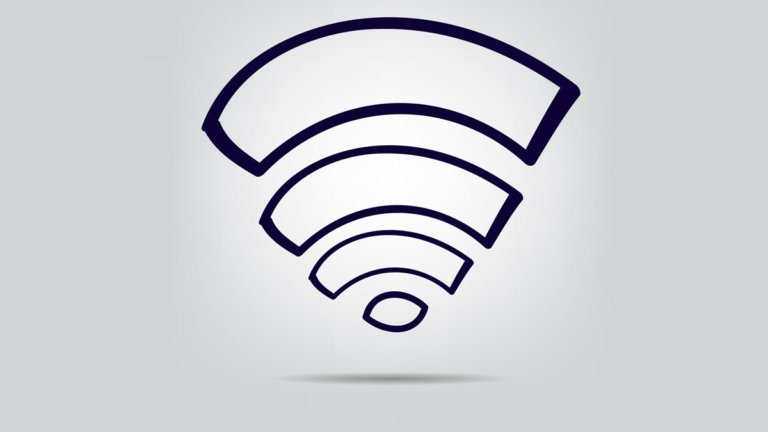
If you have been tracking CableLabs’ work to ensure that the introduction of LTE into unlicensed spectrum does not do disproportionate harm to Wi-Fi consumers, you may have noticed that it has been a while since we wrote in this blog on the topic. That’s not because we’ve moved on, however. To the contrary, we’ve been hard at work with industry stakeholders.
News of the Week: The Wi-Fi Alliance Workshop
This week, CableLabs contributed to the second Wi-Fi Alliance (WFA) LTE-U Coexistence Test Workshop, just as we did at the first WFA event. The proceedings served as an update on work within the WFA – of which CableLabs is a member, along with 600 or so other companies, including the proponents of LTE-U – to develop consensus-based technical procedures to validate the coexistence performance of LTE-U devices. This is occurring primarily through the development of a test plan, of which a draft was released this week for informational purposes.
As Edgar Figueroa, WFA CEO noted at the event, the coexistence test plan is not complete. Since the test plan is to be used in its entirety as a holistic suite of tests that LTE-U devices must pass, we must reserve final judgment until it is complete. But it looks promising at this stage.
Principles for LTE-U Coexistence Testing
As we outlined at the WFA workshop alongside Google, Broadcom, and Comcast, any satisfactory test plan must:
- Specify a rigorous and realistic set of test cases that validates LTE-U ability to coexist fairly with Wi-Fi;
- Not simply be a demonstration of equipment’s ability to satisfy the LTE-U Forum Coexistence and CSAT specifications, or vendor solutions and claims, which are insufficient to prove coexistence;
- Include clear, quantified pass/fail metrics to ensure that LTE-U does not disproportionately degrade Wi-Fi performance; and,
- Be conducted in an open manner, with results available to the public.
The current draft of the WFA test plan appears to be on a path to meet these criteria. Some important test cases have yet to be written – for example, verifying that Wi-Fi consumers will still be able to choose their preferred network even in the presence of LTE-U – and we are working with the WFA to see that this and other unfinished pieces proceed expeditiously to completion.
Once the test plan is complete and verified to be effective, LTE-U devices will start proceeding through the tests. If a device passes the full suite of tests, stakeholders should (ideally) be assured that Wi-Fi consumers will not be harmed by its deployment. If a device fails a part of the WFA tests, then it will be clear that improvement in its coexistence technology is needed before it is introduced to the marketplace.
An Evolution in Tone
The cautious optimism of the day is in contrast to the tone of the LTE-U debate in 2015. Then, the discourse was marked by competing technical studies and at-odds assertions. Now, a common, industry-led technical engagement may produce definitive results. A couple of takeaways come to mind:
First, given the substantial effort of the unlicensed community to develop test procedures within the WFA, it should be clear to all that the bare-bones test cases in the LTE-U Forum Coexistence Specification are vastly inadequate – as we have been saying for some time.
And second, given the progress to date, industry collaboration must be given time to play out. Though it is proceeding expeditiously, work within the WFA is not done, and can only serve to validate LTE-U coexistence as a whole work product.
That is an important point that was missed in press coverage of the FCC’s recent grant of an experimental license to Qualcomm. In a blog post, Julius Knapp of the FCC was careful to distinguish between those independent experiments and the collaborative coexistence process of the WFA. Any testing that is based on a draft, incomplete set of technical procedures cannot, by definition, yield meaningful information on LTE-U coexistence. The independent experiments that will be conducted by Qualcomm under this grant of temporary authority are much different than the collaborative industry process that remains underway at the WFA.
3GPP Parallels
We certainly hope that the work in the WFA will lead to meaningful assurance that Wi-Fi consumers will not be harmed. For that to occur, the WFA test plan is likely to only be a start, even if it is proven to be rigorous in its final form. It is possible that evolution in LTE-U technology will be needed as well. That is how the development of License Assisted Access LTE (LAA-LTE) has occurred in 3GPP, the mobile standards body.
In 3GPP, a robust technical debate has led to improvements in coexistence features, with listen-before-talk procedures that should make the technology more friendly to its neighbors in shared, unlicensed spectrum. Work is just now beginning to simulate the efficacy of LAA coexistence properties. If the WFA coexistence testing model proves to be effective in protecting wireless consumers, it may also be adapted to LAA.
What’s Next
LAA is scheduled to be part of 3GPP’s Release 13 in March, and work within the WFA to develop the LTE-U coexistence test plan should be nearing completion around that time as well. Stay tuned… it looks like 2016 will see some major developments for wireless consumers.
Jennifer Andreoli-Fang and Bernie McKibben also contributed to this article.
Rob Alderfer is Vice President of Technology Policy at CableLabs.
Consumer
Fair LTE-U Coexistence Far From Proven In CableLabs / Qualcomm Testing
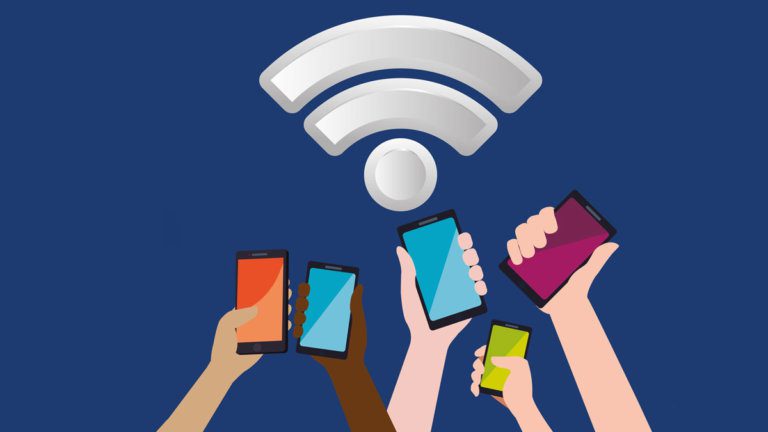
CableLabs has been working hard to ensure that the introduction of LTE into unlicensed spectrum is a win for wireless broadband, and that it does not disrupt the Wi-Fi services that consumers have come to rely on. We have covered in prior posts why that is a challenge, since LTE-U can take advantage of Wi-Fi’s inherent politeness. Here we will review recent technical work we did with a major proponent of LTE-U, Qualcomm Technologies, and explain why that effort only reinforces our concerns.
In brief, we observed that current LTE-U prototype equipment is quite primitive — it is really just in mock-up state at this point — and incapable of demonstrating important coexistence features. The vendor-promised features, most of which are not required or even identified by the LTE-U Forum in its latest specifications, are not yet working to enable fair and reliable coexistence and confidence in testing. In addition, we found that claims of its ability to share fairly rest on a seemingly faulty understanding of how Wi-Fi shares spectrum. For CableLabs, this reinforces the need for a collaborative and open standards development process.
The Wi-Fi community has long sought the same collaborative standards development process for LTE-U that LAA has enjoyed (License Assisted Access LTE is the flavor of unlicensed LTE being developed in the mobile standards body, 3GPP). But in the absence of LTE-U standards development, CableLabs has engaged directly with the promoters of LTE-U in an attempt to do the fundamental research required to find coexistence solutions. Far from converging on solutions, however, our work to date on LTE-U has raised more questions than answers.
Lessons Learned with Qualcomm’s LTE-U
CableLabs recently concluded a brief technical engagement at Qualcomm’s campus in San Diego, which was preceded by a lengthy negotiation of what we would be allowed to test on site. Ultimately, the scope of the plan was much narrower than our guidance and focused on a limited set of basic coexistence tests. It certainly was not the fulsome research that we recommended and is required to address the concerns of Wi-Fi technologists, which we summarized in a presentation to the Wi-Fi Alliance last week.
We began this limited test hoping that we would be able to independently validate the definitive statements of LTE-U proponents that it has been ‘proven to coexist’, and is ‘more friendly to Wi-Fi than Wi-Fi is to itself’.
Unfortunately, our main conclusion from the three weeks we spent on site at Qualcomm is that there is no basis for definitive technical statements about LTE-U coexistence. The reason for this is surprisingly simple: LTE-U is in a prototype phase of development, and does not possess the features that its proponents have noted are important to coexistence.
For instance, Qualcomm has noted that their LTE-U solution will sense the spectrum for Wi-Fi activity and adjust its duty cycle ‘on’ time for rapidly changing congestion conditions. But that is not what we were shown. What we saw was an LTE-U prototype that must have its duty cycle manually programmed; it has no adaptation capabilities at all. There were other issues as well: For example, the equipment did not natively use the 5 GHz band that is targeted for LTE-U, and it only supported a single user device. We will refrain from going on at length here, but as is apparent in the photo below, LTE-U requires substantial further development. In short, we were surprised to see that the state of the art plainly won’t work in the real world, despite assurances to the contrary and claims of comprehensive testing.
Importance of a Common Research Framework
Since LTE-U equipment is not mature, it should come as no surprise that coexistence research leaves much to be desired as well. Statements that LTE-U is ‘more friendly to Wi-Fi than Wi-Fi is to itself’ necessarily rely on a baseline understanding of how Wi-Fi shares the spectrum with other Wi-Fi networks. But, in our three weeks at Qualcomm, engineers spent the majority of the time grappling with that crucial baseline information. The test setup at Qualcomm was uncontrolled and provided strangely imbalanced measurements. Afterwards, a CableLabs engineer replicated the setup at our Colorado facilities with the same make of Wi-Fi equipment, and within a half hour obtained balanced results, suggesting that problematic baseline measurements were somehow endemic to Qualcomm’s research environment. CableLabs and its members regularly test, configure, and operate Wi-Fi networks, and the behavior we observed on-site in San Diego seems quite out of the ordinary. Selected baseline measurements are shown in Figure 2 below, including the expected balanced baseline we observed in our Colorado lab.
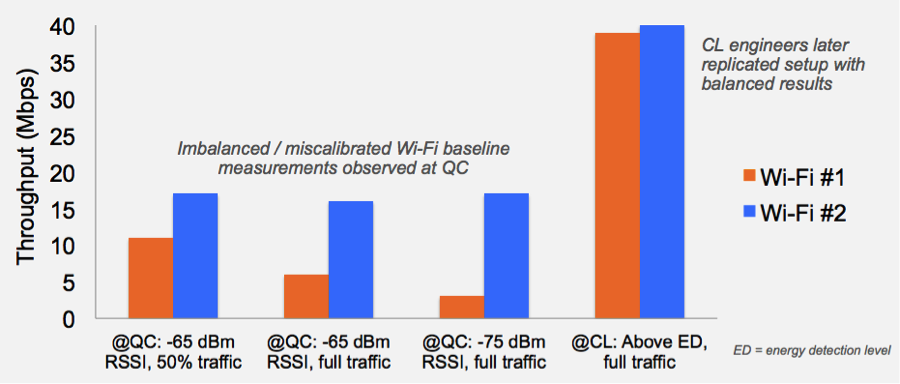
Figure 2: Imbalanced Wi-Fi baseline behavior in Qualcomm research not observed in follow-on CableLabs work
This highlights the fundamental problem with the LTE-U coexistence research done to date: There is no common technical framework in which stakeholders are working, which makes it very difficult, if not impossible, to interpret research results across studies. This is apparent in our limited work with Qualcomm, and in Qualcomm’s prior studies, which also reflect baseline imbalances and call into question the research conclusions of LTE-U proponents.
Since we spent most of our time at Qualcomm working to diagnose apparent problems with the research environment, we did not come close to executing against the already modest test plan developed at the outset. We did however take some limited measurements of Wi-Fi behavior in the presence of LTE-U (which was tuned to 50% duty cycle ‘on’ time, so is only a narrow representation of possible real-world LTE-U configurations).
As seen in Figure 3 below, the impact of LTE-U depends on what your comparison point is: To conclude that LTE-U coexists better than Wi-Fi, one would need to lower the bar as much as possible — using an imbalanced baseline and referencing only the lower end in the analysis. This would clearly be a skewed approach, and even when doing so, it still doesn’t tell a conclusive story — reference the first case in the figure below, where the presence of LTE-U degrades Wi-Fi more than either baseline case. We would submit that the better approach is to diagnose the problems with the baseline measurements, rather than using unexplained results to justify definitive conclusions.

Figure 3: LTE-U coexistence not reliably determined
Furthermore, the in-home research detailed in a recent blog post by our principal architect, Jennifer Andreoli-Fang, made it clear that LTE-U is likely to have a disproportionately negative impact to Wi-Fi when the baseline is properly calibrated. An open standards process with common research methods is clearly needed to drive greater consistency and confidence in results.
We certainly hope that Qualcomm’s LTE-U solution will move from prototype to product in the near future, so that the Wi-Fi community can attempt to validate its coexistence efficacy in an open and comprehensive fashion. But that would only be one necessary step on the path toward equitable spectrum sharing. As we have detailed before, the LTE-U Forum coexistence specification leaves substantial room for different vendor and carrier approaches, which are likely to do disproportionate harm to Wi-Fi.
While this quite limited testing at Qualcomm’s facilities raised more questions than answers for us, CableLabs remains fully committed to rectifying the shortcomings in unlicensed LTE coexistence. Indeed, we have seen more hopeful progress in the development of the global standard form of the technology, LAA-LTE, which we are cautiously optimistic is on a path to coexist well. The more aggressive approach taken by LTE-U clearly poses significant challenges, but we see promise in the open standards process and the particular technical choices of LAA as the basis for a more effective and comprehensive solution.
Reliable coexistence in unlicensed spectrum requires a broadly supported agreement on specific solutions. That is why a collaborative, open standards development process is so important — that is how Wi-Fi is developed. Its success is self-evident in the marketplace.
Rob Alderfer is Vice President of Technology Policy at CableLabs.


